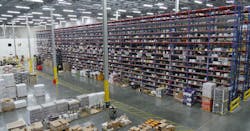Emerging Technologies in Warehousing and Distribution
Not only is the cold storage market projected to explode to $372.29 billion by 2030, one of the main market dynamics is energy-efficient cold storage warehousing. With the spike in frozen storage that accounted for 77.91% share of cold storage global revenue in 2021, companies are quickly turning to automated storage options. Eco-friendly, automated storage solutions are rising in demand on a global scale. In fact, the automated storage and retrieval system (AS/RS) market reached $18.03 billion in 2021, and is expected to reach $27.68 billion by 2027. Given that low carbon, energy-efficient designs are “anticipated to fuel the demand for cold storage,” implementing an AS/RS can provide green benefits as well.
Based on these market trends, manufacturers and distributors are going to need to find in-house storage solutions for their operations. Companies should evaluate their warehousing operations through a data-centric approach in order to produce a customized solution that ensures storage space is optimized and the warehouse is set up for future growth.
An Eco-Friendly Solution while Maximizing Existing Space
One of the main reasons that businesses transition from conventional to automated warehousing is to increase storage space and save on costs, enabling the use of existing buildings or utilizing a site that is smaller. A high-density AS/RS can be designed to fit in any existing structure. In addition to being one of the most environmentally-friendly warehouse designs, AS/RSs can be built up to 140’ high, maximizing vertical storage space and improving the utilization of an existing property. When compared to a conventional warehouse with equivalent product inventories, an AS/RS can reduce the square footage of the building by as much as 200% to 400%, depending on height and density. Energy consumption and waste production are also significantly decreased with a multi-deep AS/RS. Waste is reduced thanks to less manual product handling, including the errors derived from human mistakes in order picking, helping to reduce environmental consequences like repackaging and shipping. Investing in an AS/RS is environmentally conscious and can eliminate the need for offsite storage.
Triple Rail Support
For wood pallet types like CHEP, GMA and others, deflection is a common and sometimes costly issue, especially with heavy pallet loads. Two points of support are often not enough to ensure the pallet is not overstressed, which can lead to failure. With triple rail support, pallets can be distributed more proportionately, making it a suitable storage option for any industry handling medium to heavy loads.
A Data-Centric Design
The right warehouse automation partner will have a team of engineers and solutions analysts who are dedicated to a data-centric approach to design reliable and robust systems. Properly analyzed data is used to determine what areas of the warehouse would benefit most from automation, and that requires more information than simply using summary data. Considering that one of the main factors that contributes to poor warehouse automation design is missing or inaccurate data, it is crucial to choose a partner who cares about the “why” behind data and who has the tools to implement that information into the overall automation design.
Total Control with a WES
It is well known that software applications like warehouse management systems (WMS) and warehouse control systems (WCS) help move products more efficiently, provide inventory control, and improve order fulfillment accuracy. However, without seamless integration of these systems, more time and resources are used to support them individually. Because warehouse automation is only as good as its software, businesses looking at automation options should seek one that is controlled with a warehouse execution system (WES).
Featuring both WMS and WCS functionalities, a WES simplifies processes like inventory and order management, billing, workflows and integration with existing ERP software. A WES can help improve product traceability, reduce recalls and provide total inventory control.
Ultimately, the AS/RS industry is quickly becoming one of the fastest growing industries across the globe, and for a plethora of valid reasons. Thanks to its sustainable design, AS/RS is projected to rise in popularity with environmental, social and governance (ESG) considerations at the forefront for organizational initiatives and goals. However, it is important for companies to partner with automation experts that offer unique features like triple rail support, prioritize the details of data, and utilize an intelligent WES.
Ryan Smith is vice president of automation with Westfalia Technologies Inc., a provider of warehouse automation solutions.
About the Author
Ryan Smith
Ryan Smith is vice president of automation with Westfalia Technologies Inc., a provider of warehouse automation solutions.
